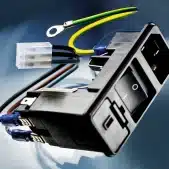Although specifically dealing with aircraft systems, the methods described in this article are applicable for other platforms where a number of antennas are in close proximity. The number of antennas in use and in close proximity on mission specific aircraft are as many as 22 on a small search and rescue aircraft. ANALYSIS METHODS The methods of coupling analysis include … [Read more...]
Use of Ferrite-Loaded Absorber to Reduce Wireless Self-Interference
Self-generated EMI from DC-DC converters, as well as digital and video processing, has long plagued designers of wireless and IoT devices, especially since physical sizes have trended smaller. The broadband harmonic content often extends up through 1.5 GHz, which includes most wireless protocols, cellular LTE and GPS/GNSS bands. One new mitigation technique I’ve been trying … [Read more...]
5 Ways to Eliminate Ground Loops — Part 2
As we discussed in Part 1, Ground Loops, while often not obvious, can be a significant source of frustration for system operators and integrators. This phenomenon manifests as unwanted electrical noise – audible hums in speakers, jitter on screens, noisy measurements, and bad measurement data – and it can even lead to unexpected communications loss and equipment … [Read more...]
5 Ways to Eliminate Ground Loops — Part 1
A Brief Introduction Most workers already know that proper grounding is a fundamental safety precaution for all kinds of electrical equipment. However, it’s less well known that while grounding can prevent and resolve many safety and power issues, improper grounding can create problems in data logging, data acquisition, and measurement and control systems. One of the most … [Read more...]
FCC Rules to Open Supplement Coverage from Space (SCS) to Assist Emergency Services
In March 2024, the Federal Communications Commission (FCC) adopted rules to facilitate the deployment of supplemental coverage from space (SCS). The new rules are intended to serve several important public interest goals for the Nation and expand the reach of communications services, particularly emergency services, so that connectivity and assistance are available in more … [Read more...]
5 Ways Signal Noise Can Impact Electrical Equipment
Accurate data acquisition is often critical in various engineering and technical projects. However, a pervasive yet often-overlooked issue that arises in the system is signal noise. This unwanted electrical interference, originating from multiple sources, can corrupt measurements, hinder communication, and compromise equipment integrity. Recognizing the Symptoms: … [Read more...]
The Industrialization of Satellites
Santa Rosa, California, December 28th, 2023 – The use of satellites in space has historically focused on the aspects of science, communication, and military. This will change massively in the future. Whole swarms of small satellites orbit the globe and supply mankind with Internet access. Modern day satellites are packed with state-of-the art electronics. They must be as small … [Read more...]
SCHURTER Classic Power Entry Module with Circuit Breaker Gets Even Better
Santa Rosa, California, November 30th, 2023 – SCHURTER series DG11 and DG12 with and without main filters feature a first-of-its-kind ingress protection solution for IEC inlets, consisting of a seal gasket between the connector and mating V-Lock power cord. The blue colored latch of the V-Lock power cord and blue inlay of the appliance inlet indicate that the two have been … [Read more...]
Customized Wire Harness Solutions by SCHURTER
SCHURTER is pleased to announce its wire harness solutions with ready-to-connect cables, cable bundles and complete wire harnesses with connectors, contacts, or wire-end sleeves. Wire harnessing requires a special electrical engineering know-how to ensure end-to-end quality of product installation and performance. SCHURTER’s widespread offering of components and wire harness … [Read more...]
Connectivity for Off-Road Vehicles – Part 3
Zonal Architecture for Vehicles Zonal architecture is the name given for the new structure of vehicle electronics. In contrast to a traditional vehicle in which systems are grouped by function, zonal architecture offers a more efficient solution. The functions within a vehicle are grouped by location into several zones. Each zone is responsible for the devices that are … [Read more...]
- 1
- 2
- 3
- …
- 26
- Next Page »














